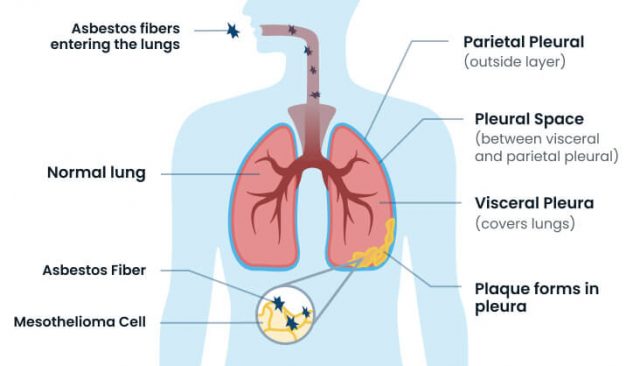What Is Pleural Mesothelioma?
Pleural mesothelioma is a cancer that develops when asbestos fibers cause damage to the lining of the lungs. The pleural lining, known as the pleura, is part of the mesothelium, which is a layer of protective tissues that protects organs in the chest and abdomen.
Of the 3,000 cases of mesothelioma diagnosed each year, about 2,100 to 2,370 are pleural mesothelioma. Occupational asbestos exposure is the No. 1 cause of mesothelioma. Occupations that put workers most at risk include construction, automotive, plumbing, electrical and insulation work.
Symptoms of malignant mesothelioma of the pleura include shortness of breath, chest pain, fluid around the lungs, dry cough, wheezing and fatigue. There is no cure for the disease, but treatment can improve survival. The average life expectancy for pleural mesothelioma without treatment is about eight months. However, treatment can extend survival to a year for late-stage cases and possibly several years for early-stage cases.

Pleural Mesothelioma Symptoms
Initial mesothelioma symptoms, such as chest pain and difficulty breathing, may resemble those of less serious conditions, including pneumonia and bronchitis. Patients may put off seeing a doctor until these symptoms worsen, and doctors may misdiagnose the condition until more serious symptoms develop.
As the disease progresses, growing tumors may cause advanced symptoms that can include night sweats, nerve pain and difficulty swallowing.
- Shortness of breath
- Chest pain
- Dry or raspy cough
- Fluid in the lungs (pleural effusion)
- Pain in the lower back or rib area
- Fatigue
- Weight loss
- Fever
- Night sweats
- Swelling of the face or arms
- Nerve pain
- Difficulty swallowing
- Lumps under the skin on the chest
There is a 20- to 50-year latency period between the first exposure to asbestos and the development of malignant pleural mesothelioma. This mesothelioma latency period makes it hard for patients to recall when and how they were exposed to asbestos. Those unaware that they were exposed to asbestos may not know to look for these symptoms in the decades following exposure.

Causes and Risk Factors of Pleural Mesothelioma
Asbestos exposure is the primary cause of mesothelioma. Inhaling asbestos fibers causes inflammation, scarring and damage to cells that can lead to cancer in the lining of the lung. It takes decades for this damage to create DNA changes that cause tumors to form.
Working in certain industries that used asbestos products in the past, such as construction, plumbing and mining, is a major risk factor for pleural mesothelioma cancer. Other risk factors include asbestos exposure while serving in the U.S. military, living with someone who works with asbestos products or living near an asbestos mining site. Exposure to erionite and zeolites, which are similar to asbestos, have also been shown to cause mesothelioma.
Researchers have investigated other potential causes of mesothelioma, including exposure to radiation and simian virus 40, but the primary proven cause of mesothelioma is asbestos exposure.
Diagnosing Pleural Mesothelioma
The diagnostic process often moves quicker for patients who know their history of asbestos exposure and ask their doctors to test for asbestos-related diseases. If a patient is unaware of their prior asbestos exposure, doctors will test for less serious conditions before considering mesothelioma because it is a rare cancer.
Imaging scans and tissue biopsies are the primary tests used to reach a mesothelioma diagnosis. Blood tests also play a role, but a biopsy is the most important test to diagnose pleural mesothelioma.
- Imaging Scans: When cancer is suspected, imaging scans play a vital role in guiding doctors who are collecting a tissue sample for biopsy testing. CT scans, PET scans and MRIs are used to detect where cancer may be forming.
- Biopsy: A thoracoscopic biopsy is the gold standard biopsy test to diagnose pleural mesothelioma. It allows pathologists, who study cancer cells, to identify the exact type of cancer a patient may have.
- Blood Tests: While blood tests cannot diagnose mesothelioma, they can help doctors rule out other conditions and monitor your overall health and response to treatment.
Discovering the exact cell type of a tumor through biopsy testing is how doctors determine whether a person has mesothelioma or another type of cancer. The most common cell type found in pleural mesothelioma tumors is epithelial. Biphasic is the second-most common, followed by sarcomatoid.
Misdiagnosis
Pleural mesothelioma is often initially misdiagnosed as less serious pulmonary conditions such as bronchitis or pneumonia. It may also be misdiagnosed as a form of lung cancer. Misdiagnosis delays proper treatment and may impact a patient’s prognosis.
It’s important to know if you have a history of asbestos exposure and to share that history with your doctors if you develop pulmonary symptoms. Seeking a second opinion from a mesothelioma specialist is the best way to get an accurate diagnosis and the best possible treatment.
Pleural Mesothelioma Staging
Mesothelioma staging helps doctors track tumor progression and spreading. It also helps them determine the best course of treatment. Two staging systems, the TNM and SEER systems, are used to stage pleural mesothelioma. The TNM system is more commonly used and has four stages, while the SEER system has three that classify tumors as local, regional and distant.
The four TNM stages provide a more detailed classification based on tumor size, lymph node involvement and metastasis, or spreading.
- Stage 1: At the first stage, cancer is contained within the pleural lining and may be surgically removed. Median survival is 22.2 months, but some stage 1 mesothelioma patients live longer than three years.
- Stage 2: In the second stage, cancer has spread beyond the pleural lining and into lung tissue and possibly nearby lymph nodes. Surgery remains an option. Median survival is 20 months, with some stage 2 mesothelioma patients living longer than three years.
- Stage 3: In the third stage, cancer has spread throughout the chest cavity, including lymph nodes. Surgery may be an option for some stage 3 mesothelioma patients. Median survival is nearly 18 months.
- Stage 4: By the fourth stage, cancer has spread widely throughout the chest cavity and may have spread beyond the chest to the back or distant organs, known as metastasis of mesothelioma cancer. Median survival for stage 4 mesothelioma patients is nearly 15 months with chemotherapy and immunotherapy treatment.
Accurate staging is important in administering the best course of treatment. The wrong treatment could be given if pleural mesothelioma is incorrectly staged, which could have a negative impact on patient survival and quality of life. Delivering the right treatment at each stage improves patient survival, reduces the risk of complications and has a positive impact on quality of life.
Pleural Mesothelioma Prognosis & Life Expectancy
Doctors use terms such as prognosis, life expectancy and survival rate to refer to how mesothelioma will affect your overall health and life span. Prognosis refers to how the disease will affect your health, while survival rate and life expectancy refer to how it will affect your life span.
The prognosis for mesothelioma is considered poor because there’s no cure for this terminal disease. Most patients have a life expectancy of one year, but early-stage patients often live longer than three years. The five-year survival rate is 10%.
Other types of mesothelioma have different survival rates. For example, about half of peritoneal mesothelioma patients live longer than five years if they undergo surgery with heated chemotherapy.
Certain factors are associated with longer survival.
- Early Stage: Patients diagnosed in stage 1 or 2 have the best chance of long-term survival.
- Cell Type: Patients with epithelioid tumors live longer than patients with biphasic or sarcomatoid tumors.
- Sex: Women are more likely to live longer with pleural mesothelioma than men.
- Age: Younger patients respond better to treatment, and this helps them live longer with mesothelioma.
Patients may improve their prognosis by working on their overall health. Lifestyle and nutritional choices can have a positive impact on the immune system. This includes getting enough sleep, exercising regularly, avoiding alcohol and eating a balanced diet.

Pleural Mesothelioma Treatment
Mesothelioma treatment helps patients live longer and more comfortably with the disease. Without treatment average survival is around six to eight months, but treatment may add months or years to a patient’s life expectancy.
Innovations in treatment, newly approved drugs and clinical trials have offered renewed hope to families facing a mesothelioma diagnosis. The U.S. Food and Drug Administration approved two new treatments for pleural mesothelioma in recent years: Tumor Treating Fields therapy and immunotherapy with Opdivo and Yervoy, known generically as nivolumab and ipilimumab.
Multimodal treatment involves combining two or more treatments and offers the best survival rates to patients at every stage. It requires doctors in different disciplines to work together on a patient’s treatment plan. This is known as multidisciplinary care.
While there is no cure for mesothelioma, treatment can extend survival. Palliative care for pleural mesothelioma aims to improve symptoms and a patient’s quality of life. It involves medications and complementary therapies such as physical therapy and occupational therapy.
Surgery
Surgery for pleural mesothelioma ranges from minimally invasive procedures, such as a thoracentesis to drain pleural fluid, to aggressive tumor-removing procedures.
Tumor-removing surgery offers the best chance at long-term survival. These procedures begin with a thoracotomy, which is a procedure that allows surgeons to access the chest and lungs through an incision along the ribs.
An extrapleural pneumonectomy, or EPP, removes the entire affected lung and other nearby tissues. A pleurectomy and decortication, or P/D, spares the lung but removes the pleural lining and other affected tissue. Some surgeons use robotic surgery to perform these procedures, which reduces blood loss and shortens a patient’s recovery time.
Chemotherapy
Chemotherapy for pleural mesothelioma may be administered intravenously throughout the body, known as systemic chemotherapy, or applied directly to the pleural lining during surgery, which is called hyperthermic intrathoracic chemotherapy, or HITHOC.
Hyperthermic intraperitoneal chemotherapy, or HIPEC, also known as heated chemotherapy, was originally developed to treat peritoneal mesothelioma.
The two most effective chemotherapy drugs for pleural mesothelioma include cisplatin and pemetrexed (Alimta). Other effective chemotherapy drugs for the disease are carboplatin, gemcitabine (Gemzar) and doxorubicin.
Radiation Treatment
External beam radiation therapy involves high-energy rays aimed directly at pleural tumors. The most effective type of this form of radiation therapy for mesothelioma is called intensity-modulated radiation therapy. It offers varying strengths of radiation beams, which helps radiologists target tumors.
Another type of radiation, called brachytherapy, delivers radiation through small implants inserted into or near the cancer. This type of radiation is used less often for pleural mesothelioma than other types.
Radiation may be delivered alone to treat painful chest wall tumors, or before, during or after surgery as part of a multimodal treatment approach. A study on surgery for mesothelioma after radiation therapy, also known as SMART, showed 66% of participants with pleural mesothelioma lived longer than three years. Intraoperative radiation is administered to help prevent tumors from spreading to surgical incisions.
Pleural Mesothelioma Specialists
Pleural mesothelioma specialists are located throughout the U.S., and they often work in the nation’s top cancer centers. Some of the most well-known mesothelioma specialists are surgeons, but oncologists and pulmonologists also specialize in pleural mesothelioma.
Dr. Raphael Bueno
Surgical oncologist Dr. Raphael Bueno is chief of thoracic surgery and vice chair of surgery for cancer and translational research at Brigham and Women’s Hospital in Boston. He serves as the program and research director of the International Mesothelioma Program at Brigham and Women’s Hospital/Harvard Medical School.
Dr. Robert Cameron
Dr. Robert Cameron currently serves as the director of the Comprehensive Mesothelioma Program at the University of California Los Angeles Medical Center. He innovated the lung-sparing pleurectomy and decortication surgery for pleural mesothelioma.
Dr. Anne Tsao
Medical oncologist Dr. Anne Tsao is the director of the mesothelioma program and the thoracic chemo-radiation program at the University of Texas MD Anderson Cancer Center, where she specializes in treating mesothelioma and other thoracic cancers.
Coping with Pleural Mesothelioma
To help cope with a pleural mesothelioma diagnosis, try building a circle of support made up of family, friends, loved ones, neighbors and community members. Support for mesothelioma patients can come in many forms, from people you know to charitable organizations, religious groups and cancer centers.
Compensation to help families afford cancer treatment is available through treatment grants, health insurance, disability insurance and certain legal options only available to those diagnosed with mesothelioma. You may qualify to receive compensation through asbestos trust funds or mesothelioma lawsuits and settlements.
Veterans with mesothelioma are eligible for additional compensation through the U.S. Department of Veterans Affairs. Disability compensation and other VA benefits are available to veterans with pleural mesothelioma.



